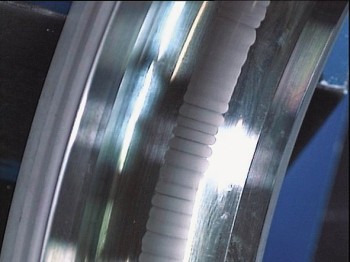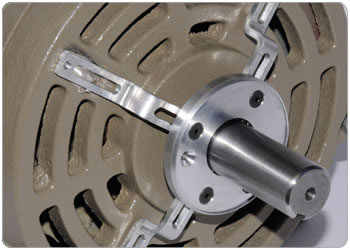
There have been cases reported where bearings have been damaged by AC drives due to bearing currents. Some of these cases are true, but most are tales that have emerged because no one bothered to investigate the actual cause of the damage to the bearing.
Another interesting fact is that bearing current damage predates AC drives and is regularly seen on line-operated pumps as well. In these instances, it is mostly due to differences in the phase-to-phase voltages driving a circulating current through the motor bearings.
If you look at drives up to 90kW/100HP, then it is rare that bearing currents are at the root of bearing damage. In many cases, the bearings have been analyzed by the bearing manufacturer after a customer claims damage from misalignment issues. When you see fluted damage to the bearing (Figure 1), current is the most likely cause. But, if the bearing is misaligned, the track will not be as ‘clean’.
If the track is displaced from the center, and especially if the pattern appears a bit angled, then it is more likely that the actual root cause of the problem is a misalignment of the bearing. This causes the bearing to push through the isolating lubrication film.
It is also important to note that if a bearing is not self-lubricated, then insufficient lubrication will also reduce the thickness of the film. This makes the bearing more prone to current damage. This is one of the reasons why damage is more common on larger motors since they are more commonly lubricated on-site.

Find and solve the root cause
Having said that, bearing currents are not a fictitious phenomenon; they are real. The use of AC drives does increase the risk of damage to the bearings. For this reason, several motor manufacturers recommend the use of isolated bearings, which should break the current flow through the bearing. There are, however, several documented cases of bearing damage even on isolated bearings, so it is not a foolproof solution. As with many other problems, it is always better to attack the root cause than to try adding a band-aid. In this case, isolated bearings really are not the optimal solution.
Shaft grounding rings are also sold to manage the circulating currents in the motor and ensure that the current bypasses the bearing and goes straight to the ground, thus preventing damage to the bearing. They are mounted around the shaft and bolted to the stator housing (see Figure 2).
While this is a widely specified solution, it is again little more than a band-aid; though this is a better one than isolated bearings. It increases the cost of the installation without dealing with the common mode voltages that are the actual root cause.
The best solution is to eliminate the source entirely. But, due to the inherent nature of an AC drive, it will create a higher potential for bearing currents. However, variable speed operation of pumps and fans provides the highest energy savings potential, and the elimination of drives is for this reason alone a very poor choice of solution, as there is no other way of regaining the energy savings achieved with variable speed.

Eliminate common mode currents
Accepting that AC drives are as necessary as mains fuses in modern installations, we need to focus on the effect of drives damaging the bearing. The root cause of the bearing currents is really the common mode currents flowing from the AC drive to the motor. So, eliminating those and securing equalization of the electrical potential in the installation will help to significantly reduce the risk of bearing current damages.
Common mode filters have been introduced to the market to help prevent these circulating currents and protect the bearings. By choosing the right filter, it is possible to reduce the levels so much that there is only an extremely limited risk of bearing current damage. When these filters are applied, the cost of isolated bearings and isolation rings can be eliminated. The cost of the filters is not a pure add-on cost, but a replacement for less efficient solutions.
The design of these filters looks much like a simple ring core (see Figure 3).

You simply pull the motor phases, not ground, through the core (see Figure 4) and make the installation as you would normally do. This also makes them excellent for retrofitting purposes. If you have had issues with bearing damage and suspect that it is bearing currents, then installing one of these filters might be a fast and easy solution. However, you should carefully evaluate if there are any alignment issues between the motor and the pump, as finding the root cause is always better than taking medicine and hoping it’s for the right disease!
The bearing manufacturer can, in most cases, assist with the analysis and provide detailed information on the root cause of the damage. If, in fact, the cause is electrical and there is a drive installed, then my recommendation would be to involve the AC drive manufacturer to investigate if there are issues with the installation contributing to the issue, before applying filters. This will make sure that other issues, which the filters do not protect from, are resolved first.
Click here to find out more about Danfoss Drives products and solutions.
Author: Frank Taaning-Grundholm, Global Sales Director, Danfoss Drives
This article was also published on: empoweringpumps.com
